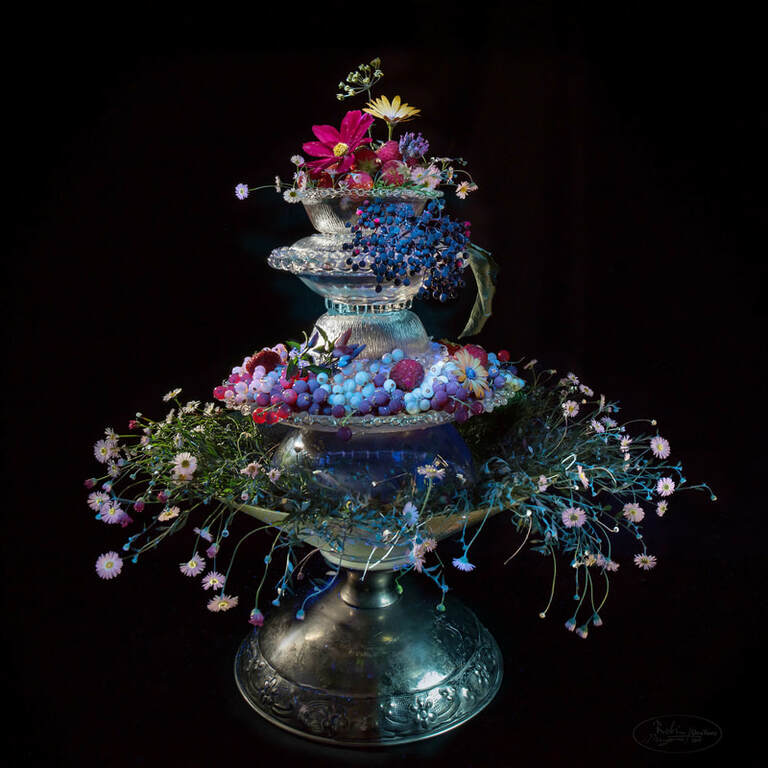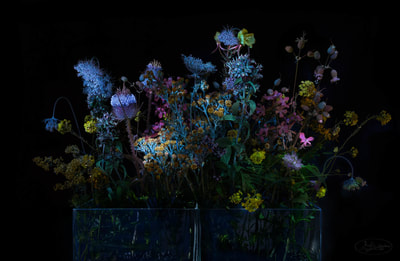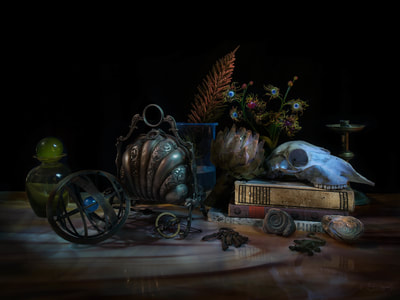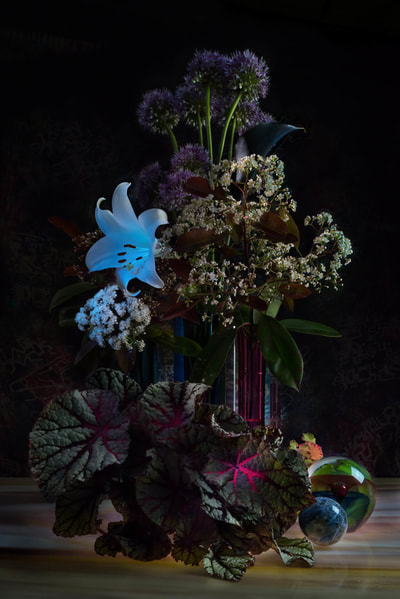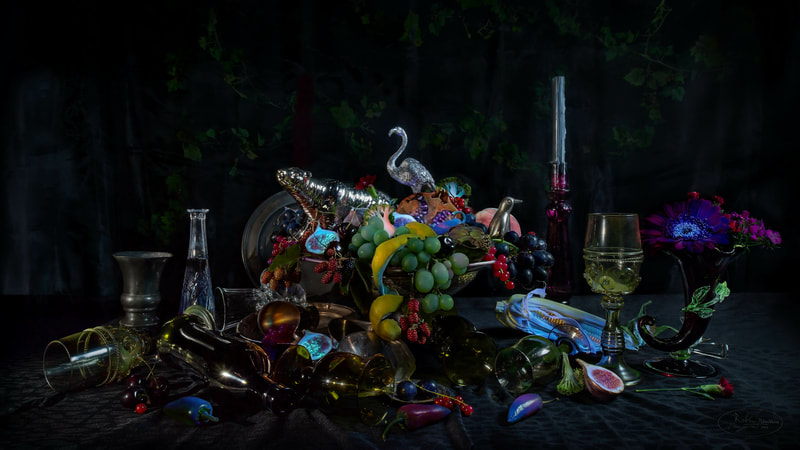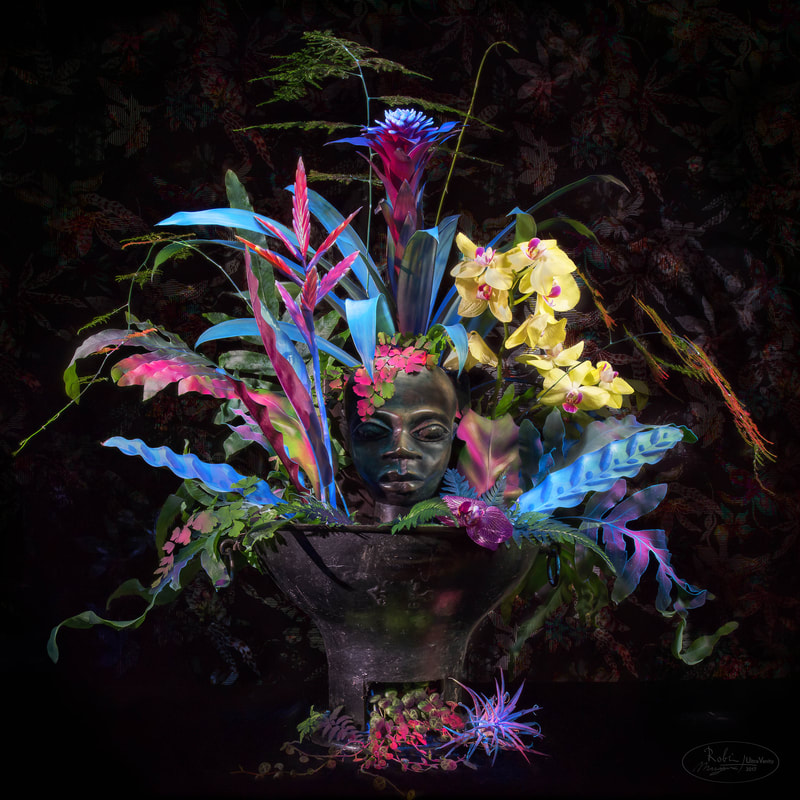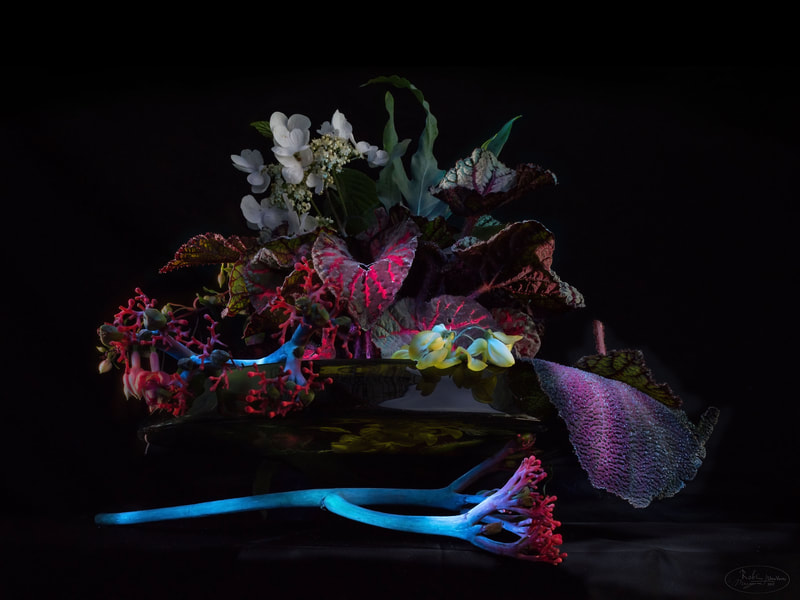ULTRA VANITY
Robin Noorda and Margot van de Stolpe collaborate in the project Ultra Vanity and use a special technique in a series of still life photographs as part of the Photosynthesis traveling exhibition collection of the Tropism Art & Science Foundation.
“The concept of our baroque series ‘Ultra Vanity’ sheds new light on plants, flowers, food, natural history objects and taxidermy objects. We arrange these in the ‘vanitas’ way of the old masters, while capturing the still life in a contemporary perception.
By means of the so called ‘Ultra Violet Induced Visible Fluorescence’ (UVIVF) technique, organic matter presents an unfamiliar colour scheme. Hereby we enter the domain of insects and birds that can see in the UV spectrum the secret messages of plants. The stamens of flowers light up bright as they have to lure insects and flower leaves show patterns that act as landing strips, leading the way to the nectar. Birds spot ripe berries and fruits in UV better. Through this magical perception shift in nocturnal colours, we aim to achieve an experience of awe and awakening. We think a different perspective and a broader spectrum invokes one to see more…”
The photographs are captured while wearing special protective goggles in complete darkness. By means of several minute long exposures in the invisible but dangerous and blinding light of a 365nm wavelength UV torch, the faint fluorescence is triggered. These photographs of the subtle phenomena of UVIVF are added together in stacks in order to gain enough luminescence to let the picture emerge.
The catalogue can be ordered here.
Robin Noorda and Margot van de Stolpe collaborate in the project Ultra Vanity and use a special technique in a series of still life photographs as part of the Photosynthesis traveling exhibition collection of the Tropism Art & Science Foundation.
“The concept of our baroque series ‘Ultra Vanity’ sheds new light on plants, flowers, food, natural history objects and taxidermy objects. We arrange these in the ‘vanitas’ way of the old masters, while capturing the still life in a contemporary perception.
By means of the so called ‘Ultra Violet Induced Visible Fluorescence’ (UVIVF) technique, organic matter presents an unfamiliar colour scheme. Hereby we enter the domain of insects and birds that can see in the UV spectrum the secret messages of plants. The stamens of flowers light up bright as they have to lure insects and flower leaves show patterns that act as landing strips, leading the way to the nectar. Birds spot ripe berries and fruits in UV better. Through this magical perception shift in nocturnal colours, we aim to achieve an experience of awe and awakening. We think a different perspective and a broader spectrum invokes one to see more…”
The photographs are captured while wearing special protective goggles in complete darkness. By means of several minute long exposures in the invisible but dangerous and blinding light of a 365nm wavelength UV torch, the faint fluorescence is triggered. These photographs of the subtle phenomena of UVIVF are added together in stacks in order to gain enough luminescence to let the picture emerge.
The catalogue can be ordered here.
Tech specs: The results are composed of stacked layers of long exposures, up to minutes. I used a 365nm light source that I bought in Hong Kong and modified with an U-340 UV bandpass filter I found in the USA, I also modified a flashlight, removing its UV filter and adding an U-340 + S8612 UV-bandpass filter. The camera used is a Nikon D810 and the lenses have an UV and IR cut filter. The lenses used are a 24mm PC Nikkor, a 70-180mm Nikkor macro, a Nikkor 105mm DC and a Laowa 15mm macro. Total costs for the filters and light source only: some € 700.
Warning, if you are planning to work with UVIVF as well, always do use yellow UV blocking safety glasses when working with UV! If not, you can blind yourself and can cause eye cancer. Also, never take UVIVF photographs of humans and animals that possibly can look directly into the UV light source.
Warning, if you are planning to work with UVIVF as well, always do use yellow UV blocking safety glasses when working with UV! If not, you can blind yourself and can cause eye cancer. Also, never take UVIVF photographs of humans and animals that possibly can look directly into the UV light source.


